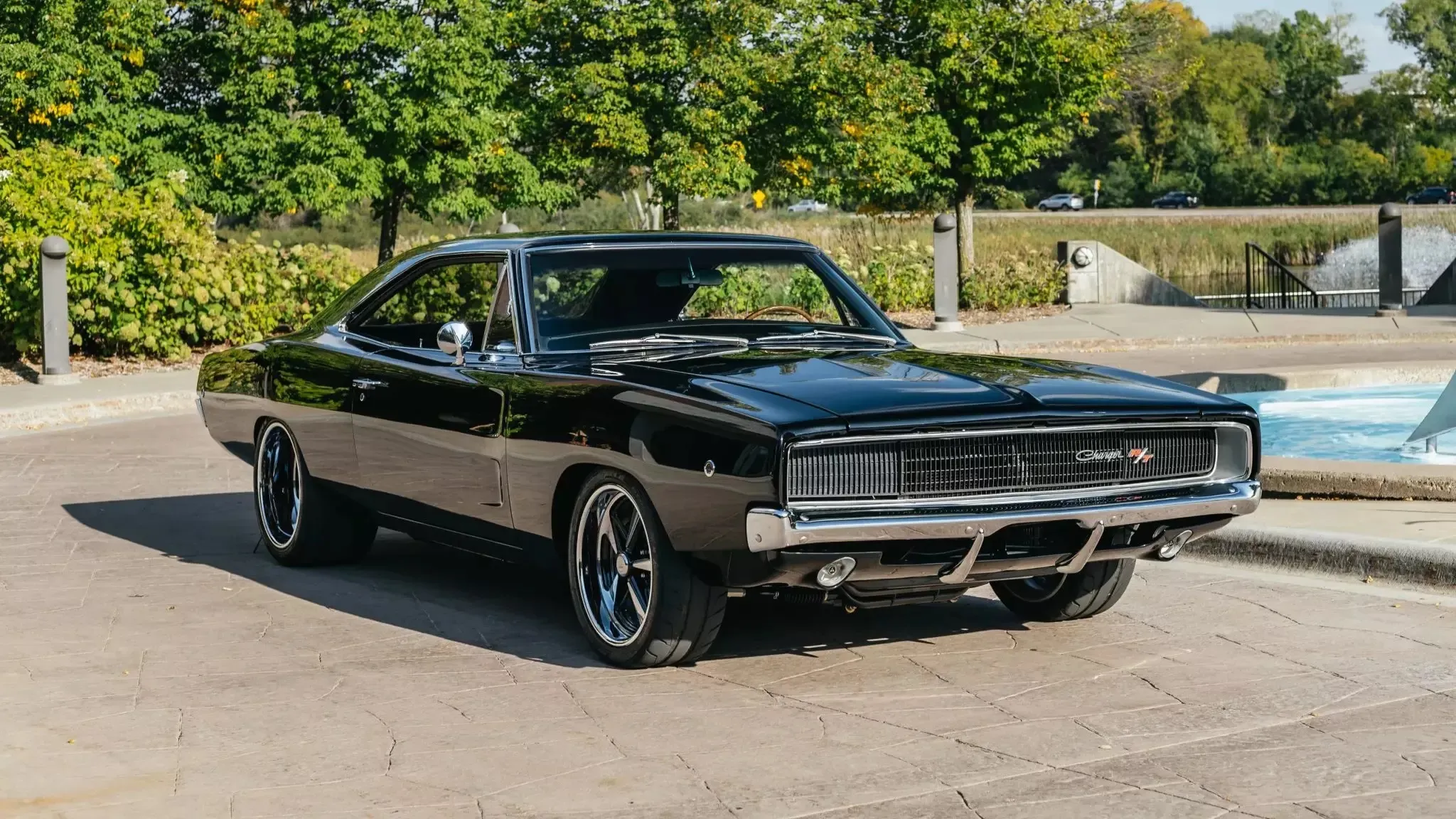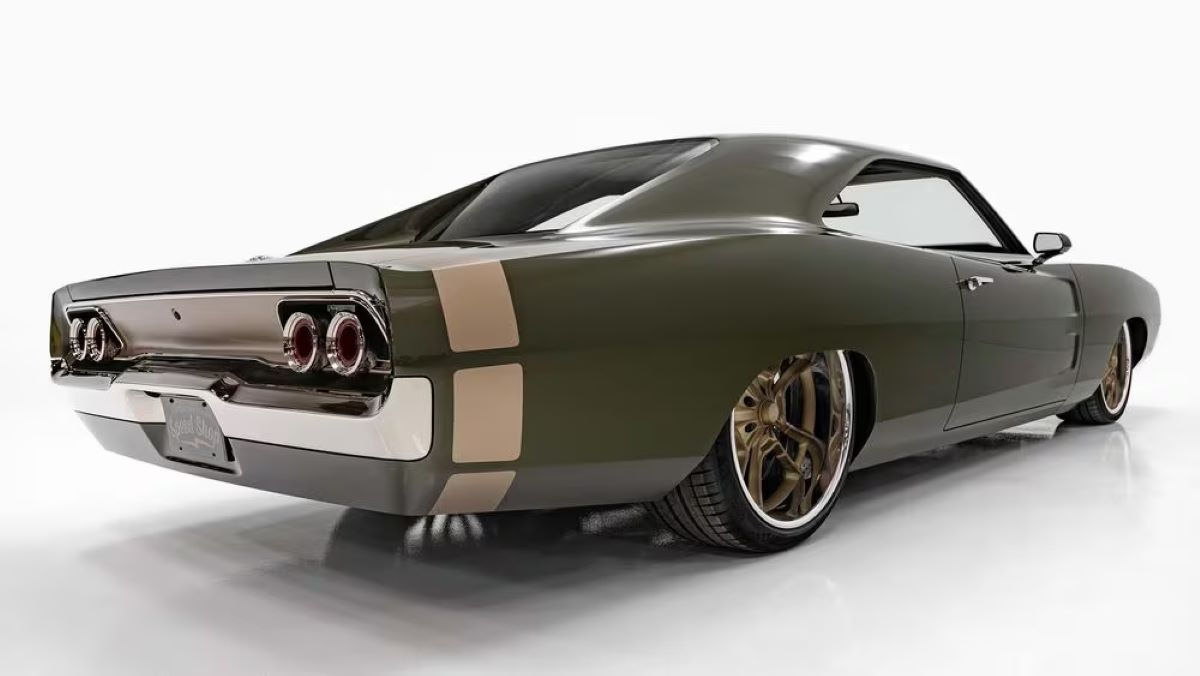When deciding on a color scheme for his new Charger build, Mopar enthusiast Ed Ganziotti had one firm requirement: “You can paint it any color you want … but it can’t be green! That’s the only thing I don’t want,” the determined owner declared.
Receiving Ed’s strict instruction was Noah Alexander, owner of the world-renowned Classic Car Studio (CCS) in St. Louis, Missouri, and the person responsible for the Charger’s “restification.”
Noah recalls their initial encounter: “We first met Ed in the checkout line at Barrett Jackson a few years before he sent us the car.
He told us about his Charger and how he wanted to do a few things to it to freshen it up and make it look more up to date. We were happy to help.” Ed has cherished the Charger for over two decades.
Originally, the B-body was crafted as a mild custom, but over time, the car was enhanced with a powerful 440-cubic-inch engine, based on the original numbers-matching motor, and built by Mopar legend Dick Landy himself.
With all the foundational elements already in place, it was just a matter of refining and assembling everything to recreate a Charger tailored to Ed’s vision.
In 2021, Ed sent his Dodge to CCS for a transformation. Noah recalls, “The plans were simple at first. Ed wanted a repaint, a new interior, and he wanted us to address some mechanical issues.
However, all that went out the window when Ed saw our shop and some of the previous work we had done over the years.
He realized our capabilities here at CCS and changed his goal. He now wanted us to build the baddest Charger on the planet.”
From that moment, the project took on a whole new energy. Eric Brockmeyer was brought in to create a rendering. Both Ed’s and CCS’s ideas were discussed, and then Eric set out to bring the vision to life.
The initial design featured the Charger coated in Black Cherry paint, but CCS had a different idea.
“Ed said we could do it in any color but green. Because of that, we knew we had to nail the color combo right from the start, so we did a complete 180, and sent him some spray outs of a custom Green BASF Glasurit we mixed up.
Bronze accents were then added in the sketch. We also sent him green leather and carpet samples as well,” Noah explains.
Despite his initial reluctance toward green, Ed loved the rendering and samples that CCS provided for his review. With the color scheme now set and parts ordered, the team moved forward at full throttle.
First, the car was disassembled and stripped down in preparation for significant upgrades.
Although several modifications were planned for the Charger’s classic Coke-bottle shape, CCS aimed to preserve the car’s original charm while enhancing the Mopar B-body’s sleek lines.
One major change involved moving the front wheels forward by three inches to achieve a long, low stance.
To make this feasible, extensive suspension modifications were required, which CCS accomplished using a custom-built Roadster Shop Fast Track chassis, adjusted to support the stretched design.
This chassis features a fully boxed frame made from 10-gauge steel and is equipped with high-performance components, including Corvette C7 spindle and hub assemblies, RideTech coil-overs, a parallel four-bar rear suspension, and a Strange Engineering Ford 9-inch axlehousing at the back.
Six-piston Baer brakes were added at all four corners, ensuring ample stopping power for this powerful ride. With the chassis in place, the CCS team shifted focus to the bodywork.
They moved the front wheelwells to accommodate the Charger’s new footprint, shaved the drip rails, tucked and fitted the bumpers, and prepared the channels for flush-mounted glass to create a modern, streamlined look.
The team meticulously sharpened the body lines with subtle metalwork and added custom body pans at the front and rear, giving the car a polished, race-inspired appearance.
In essence, almost every panel was modified to bring the build to completion. The body was then welded to the frame, creating a modernized monocoque muscle car.
Beneath the car, CCS went above and beyond to refine the suspension, smoothing out any rough areas with the same care applied to the bodywork.

Once the body and metalwork were finished, the team sprayed the Charger with the unique custom-blended green paint, setting this muscle car apart from its peers.Bronze accents, including modified Bumble Bee stripes on the rear, complemented the green finish.
Bronze details were also added to the corners and the large Billet Specialties Grinder wheels, which measure 19×8 inches in the front and an impressive 22×12 inches at the rear.
The wheels were fitted with Michelin tires sized at 265/30/19 for the front and 315/30/22 for the rear.
The interior received as much attention as the body and chassis.CCS crafted a unique, one-of-a-kind cockpit in-house.
Custom seats, along with the bespoke dash, hand-fabricated door panels, and Ringbrothers steering wheel on an Ididit tilt column, were all upholstered in Relicate leather.
A custom gauge cluster with unique gauge pods filled with Dakota Digital gauges allows Ed to monitor the car’s performance. Stainless steel accents and black walnut wood details lend the interior an unparalleled aesthetic.
Vintage Air A/C ensures comfort on hot Texas days, while a Kenwood head unit paired with Morel speakers provides top-notch sound.
As for the engine, CCS stayed true to the Charger’s roots. They retained the Landy-built 440, giving it a thorough rebuild and aesthetic upgrade.
CCS meticulously cleaned, deburred, and refined the engine block before crowning it with a Hogan intake and a Borla stack injection setup.
A Holley Terminator X fuel management system was added, pushing the 440-cubic-inch engine to over 600 horsepower on the dyno.
A GM 4L80E transmission was chosen to manage the Charger’s power.
Custom headers built in-house direct the exhaust through Borla mufflers, while an American Autowire harness connects the various systems.
Soundskins sound-deadening material was installed to keep the cabin quiet, even at full throttle. All exterior trim was given a sleek nickel finish.
After spending years observing the build process and seeing CCS’s progress videos, Ed decided to stop watching updates before the reveal.
“I asked them to stop sending me videos of the car after they started the engine.
I didn’t want to see any more videos until we revealed it at the Grand National Roadster Show where we were competing in the Al Slonaker event,” Ed shared.
When he finally saw the completed Charger, it was an emotional moment.“I flew in from Houston the day before the event and got to see the car for the first time painted and fully assembled, on display.
Seeing the car, fully completed, it exceeded all my hot-rodding dreams.”Since then, the Charger has been on a cross-country tour, and although Ed has had limited driving time, he’s thrilled with its performance.
“With the small amount of driving time I do have in the car, I’ve determined that it drives amazing on this Roadster Shop chassis—it’s like driving a track car on the street.
Also, with the original, numbers-matching 440 Magnum engine, along with Borla fuel injection, it has absolutely amazing power. To put it in a nutshell, it’s exceeded all my expectations!”

